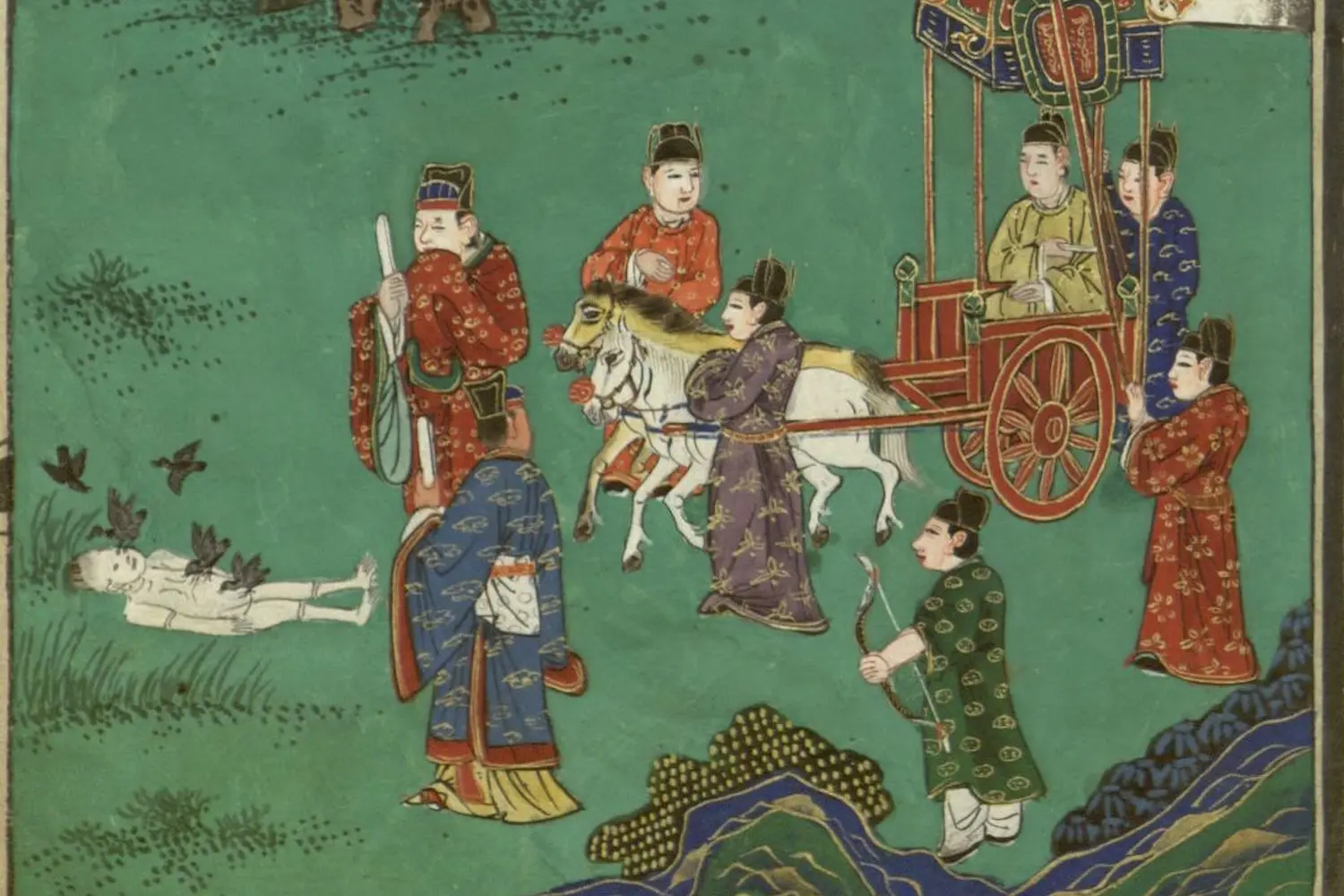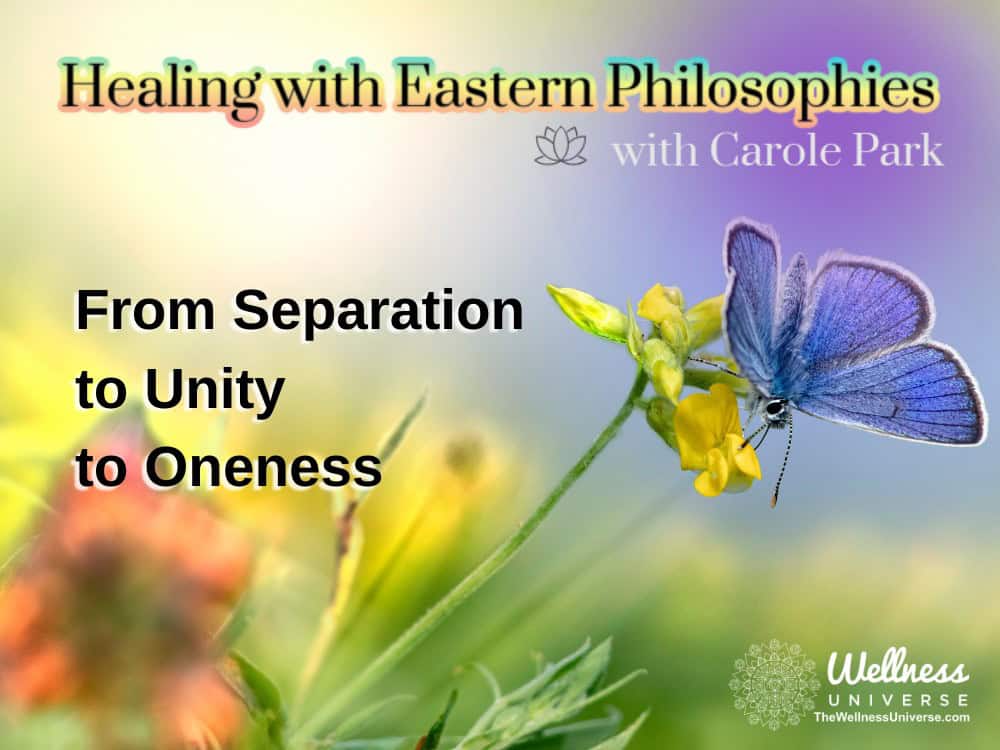Just as virtually any book about the Buddha and his teachings tells us that he was a prince (the first myth I tackled), we’re also told that he renounced his kingdom because he saw “four sights.”
This is the myth I want to tackle here.
The story of the four sights
The traditional story goes something like this:
A prophet had told the Buddha’s father, King Suddhodana, that his son would either become a king who ruled the world, or a great spiritual teacher. And so the king kept his son secluded from the world in three palaces, surrounded by every luxury, so that he wouldn’t ask questions about spiritual matters.
The Buddha-to-be was intensely curious, however, and he persuaded his charioteer, Chanda, to take him for a series of rides in and around the capital.
On the first of these journeys, the young Gotama saw a gray-haired old man, stooped, with skin covered in deep wrinkles. Being sheltered, he had never seen such a thing before.
“What is that?” he asked Chanda.
“Sire, that’s an old man!”
“How did he get that way?”
“It happens to everyone, sire. We all get old.”
“Even me?”
“Yes, sire. Even you.”
The Buddha-to-be was deeply shocked.
On a subsequent trip he saw a sick man, asked the same questions, and was shocked to the core to realize that he too was subject to sickness.
On a third trip this pattern was repeated with a dead man. Young Gotama had realized for the first time that he was destined to die.
This left him feeling very unsettled. What was the point of all this luxury, what was the point of becoming a king, if it all ended in death?
The next day he went out on another excursion, and this time he saw a holy man walking through the town. On the man’s face was a gentle smile, and he seemed unshakably calm. Although he had never been exposed to religion before, he intuitively knew that he wanted to become a spiritual seeker.
And so, late one night he sneaked out of the palace, leaving his wife and child behind. He cut off his hair and beard, gave his jewelry to his charioteer, donned humble robes, and set off on his quest.
Again, I made up the wording, but you’re probably familiar with the story from books, articles, or videos.
The four sights never happened
Here’s the thing: this never happened. The Buddha does tell a story about four sights, but it’s not about him. It’s a story about someone else: a legendary Buddha, called Vipassī, who had lived eons before. It’s Vipassī’s father, King Bandhumā, who confined the prince to three palaces. It’s Vipassī who sees the four sights. The Buddha never does.
The story doesn’t make sense of course. How did the young Gotama get from one palace to another without seeing the outside world? Was he never sick as a child? Did no one around him ever get ill? His mother was dead. Did no one ever talk about that? Had he never seen anyone getting older in his thirty-odd years of life? Pretending for a moment that Suddhodana was a king, did he have no older advisers?
A little further on I’ll write about what the Buddha’s “going forth” into the homeless life was more likely to have been like. But first, I’d like to talk about some of the parts of the scriptures that do somewhat resemble this story.
The three non-palaces
There’s a scripture in which the Buddha talks about his father having had three houses. Bhikkhu Sujato translates the word for these — pāsāda — as “stilt longhouse,” which fits the archaeological record. These “palaces” would have been two-story wooden affairs with the family livestock living beneath. The Pali dictionary gives “a lofty platform” and “a building on high foundations” as the first two meanings of pāsāda, and adds “palace” as a possible translation, but that’s not appropriate here. “Mansion” might be a reasonable term, conveying something larger and grander than an ordinary person’s house, but which isn’t an actual royal dwelling.
The non-sights
According to this scripture, the houses had lotus ponds and many servants. The Buddha-to-be had nice clothes, lovely incense, and was entertained by musicians. So he had a nice life.
But this all seemed vain in the face of life’s transience:
Amid such prosperity and such a delicate lifestyle, I thought:
‘When an unlearned ordinary person—who is liable to grow old, not being exempt from old age—sees someone else who is old, they’re horrified, repelled, and disgusted, overlooking the fact that they themselves are in the same situation.
But since I, too, am liable to grow old, it would not be appropriate for me to be horrified, embarrassed, and disgusted, when I see someone else who is old.’
Reflecting like this, I entirely gave up the vanity of youth.
This “vanity of youth” is no doubt familiar to you. When we’re young, we tend to think of the old people around us as being a bit inferior, as if they could somehow have avoided old age if they’d been more careful. The young Gotama realized that youth is on a continuum with old age, and so he ceased feeling any kind of pride at not yet being old.
He went through the same realization with respect to sickness and death.
So this is similar to the “four sights,” except that there are no “sights” in the literal sense, and there’s nothing corresponding to the fourth sight: the holy man.
He also doesn’t say that these realizations prompted him to leave home. Instead they simply prompted him to let go of the intoxications he’d had with youth, health, and life.
There’s a sense in which the four sights happened to the Buddha as psychological truths. The Buddha may well have seen an old person (or sick, or dead person) and, as if he was seeing these things for the first time, realized that these were inescapable realities that applied to him. But they certainly weren’t literal truths.
The “going forth”
The Buddha is supposed to have sneaked out of the house in the middle of the night. And yet we have this passage:
Later, while still young, a black-haired young man endowed with the blessing of youth, in the prime of life, though my mother and father wished otherwise and wept with tearful faces, I shaved off my hair and beard, put on the yellow robe, and went forth from the home life into homelessness.
Here, the Buddha’s parents were very aware that he was leaving home, and may have been present at the event. The Buddha’s mother is supposed to have died seven days after his birth. Either that’s not true or, more likely, he was referring to his step-mother, who was also his aunt, as being his mother, which she functionally was.
I find this account moving. The Buddha didn’t avoid communicating with his parents. He talked to them about his decision. With sadness, they watched him prepare to leave, and watched him go. This version of the story highlights his courage in a very human, personal way. He didn’t sneak off, unwilling to face his parents’ disappointment. Instead, he was responsible and showed his parents compassion.
The “Extensive Play”
The Lalitavistara is a well-known Mahayana Sutra that tells the story of the early life of the Buddha. It’s highly mythologized, and even includes a passage when Gotama is in heaven before taking his final rebirth — the one in which he becomes enlightened.
The title, “The Extensive Play,” communicates the idea that the Buddha’s life was a kind of act that he put on for our benefit.
This scripture has been widely influential, but it’s a relatively late addition to the body of Buddhist scriptures — probably from seven or eight hundred years after the Buddha’s death. It is however based on earlier scriptures, one of which would have been the Buddhavaṁsa, which is in the Pali canon, but again as a late addition, composed well after the Buddha’s death. It is not one of the discourses narrated by the Buddha.
So it seems that some centuries after the Buddha’s death, he became mythologized. Writers turned him into a prince. They had him live a life of improbable seclusion. They had him seeing the four sights. They portrayed him slipping quietly away from the palace in the middle of the night.
The Attadanda
But why did he go forth? One of my favorite discourses is the Attadanda Sutta — the “Discourse on Taking Up Arms.” Here the Buddha says something about the disillusionment that might have caused him to leave home.
The Attadanda is from a very old collection of texts known as the Atthakavagga, which means the “Collection of the Eights.” Some scholars believe that it may contain some of the earliest scriptures we have. I’m inclined to agree.
The Attadanda begins:
When embraced, the rod of violence
breeds danger and fear:
Look at people quarreling.I will tell of how I experienced dismay.
Seeing people floundering
like fish in small puddles,
competing with one another
— as I saw this, fear came into me.
The world was entirely without substance.
All the directions were knocked out of line.
Wanting a haven for myself,
I saw nothing that wasn’t laid claim to.
Seeing nothing in the end but competition,
I felt discontent.And then I saw an arrow here,
so very hard to see,
embedded in the heart.
Overcome by this arrow you run in all directions.
But simply on pulling it out
you don’t run, you don’t sink.
The Buddha doesn’t overtly say here that he decided to go forth from the household life, but it’s implied, and he does talk about a profound disillusionment with the violent society in which he found himself.
Politics and violence
The references to violence and to people floundering like fish in small puddles may be a reference to the conflicts that the Buddha’s tribe, the Sakyans, had with their neighbors, the Koliyans, over access to the waters of the Rohini river. This conflict is well-attested in the scriptures. Both tribes needed access to the waters of the Rohini irrigating their crops. The Rohini river, during times of drought, would dry up. This caused the two tribes to threaten violence over this precious and diminishing resource. This paralleled the way in which the fish in the river struggled in panic as they found themselves confined to ever-shrinking puddles.
The Buddha, as the son of the Sakyan chief, was in line to become a political leader. As a young man, he saw the futility and horror of violence, and also that it was inherent in political leadership.
But even worse than the threat of the neighboring Koliyans was the threat of the more powerful kingdoms of Magadha and Kosala, which were subjugating their republican neighbors. The Buddha’s Sakyan republic was tiny and weak in comparison to these kingdoms. The Buddha was surely far-sighted enough to see that Sakya had no future as an independent state. In fact, Sakya was brutally invaded by Kosala shortly after the Buddha’s death, with massive loss of life. And shortly afterward, Kosala itself was invaded by Maghada. it was a violent time.
Nowhere to go
The Buddha-to-be must have wondered, what is the point of becoming leader of a doomed country?
Thanissaro’s translation above has the Buddha saying, “The world was entirely without substance. / All the directions were knocked out of line.” Sujato’s translation makes more sense, I think: “The world around was volatile / all directions were in turmoil.”
Wherever he looked, there was violence or the threat of violence.
There was no place where he could do what he had been trained to do, which was to be a political leader. And even if he went off and lived as a farmer or trader, as the son of a former chief he would always be suspected of disloyalty by those in power. Leaders (especially kings) were paranoid and violent. He would probably be assassinated.
And so, “Wanting a haven for myself / I saw nothing that wasn’t laid claim to.”
There was no place he could be safe, secure.
Finding peace within
And then he realized that, rather than look outward for a sense of security, he could look inward, in a spiritual search. It was the painful arrow or dart of selfish craving, of a desire to “be something” that caused violence in others. The wars and threats of wars in the world around him were clashes of self-important egos competing to see who was superior. It was that same arrow of egoistic attachment to his role as future political leader that causes him to suffer too.
This arrow caused people to “run around,” competing, or to give up and “sink” into complacent obedience. He realized that his task in life would be to pull that arrow out. Which is why he “went forth” from the home life into the life of a wanderer.
(It’s perhaps not a coincidence that the external situation — conflict with the Koliyans — would have involved external arrows, and that the Buddha used the arrow as a metaphor for internal pain.)
It’s quite possible he realized that a life as a spiritual wanderer might be physically safe as well. Kings were paranoid and violent, and inclined to send their assassins after the sons of rival leaders. But there were limits. They probably wouldn’t kill someone who had explicitly renounced all worldly ties. I don’t want to make too much of this, though. I suspect the Buddha’s going forth was primarily existential, and perhaps only a little to do with personal safety, if at all. The young Gotama doesn’t sound to me like someone who did things for mixed motives. Then again, he was human. And a spiritual life would provide both physical safety and the opportunity to find and inner, spiritual security rooted in egolessness.
A going-forth rooted in reality
This version of Buddha’s going forth, then, is speculative. Like the traditional account, it’s a story. But it’s one that’s rooted in historical reality, tied to the shifting political landscape of the north-east of the Indian subcontinent, rather than in a fable about his having been locked away in palaces for his entire life.
I resonate with this more historical version of events. I can empathize with a young man being groomed for leadership and realizing that it’s all pointless. This is much more relatable to me than the conventional story of a cosseted prince seeing four sights.
And as someone who sports many gray hairs, and who has witnessed the deaths of friends and family, I can empathize too with his realization that death comes for us all.
Of course we still have those stories, which we can read and enjoy, suspending disbelief, and enjoying them as inspiring fiction.
Wildmind is a Community-Supported Meditation Initiative. Click here to find out about the many benefits of being a sponsor.
Publisher: Source link





